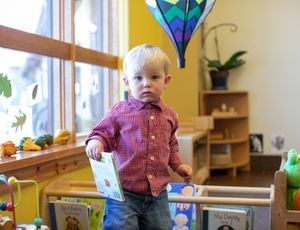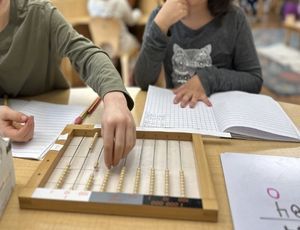During mealtimes, children develop and master an area of self-care, that of feeding. Not only is mealtime an opportunity to develop independence, but it is also when the child explores new tastes, textures, and aromas. Dr. Montessori also observed the significance of the child´s social development through food. In this article, we will look into the critical aspects of your child´s first experiences with food, and how to prepare the environment to make it suitable for a pleasant and independent experience.
When infants are around six months old, they start to experiment with their body. They can sit without any help, their movements are more coordinated, and they have more control over their hands. There are multiple signs that let us know that the child has arrived at a sensitive period of weaning. For instance, the teeth start appearing and the child uses his hands to grasp pieces of food that he finds, and the child also shows a strong interest in the food that other family members eat. Through our observations, we can identify that this child is ready to start weaning. Let’s remember that weaning does not mean removing breastfeeding or bottle feeding to rely exclusively on solids; it means that solid food will be presented to the child and each family is free to decide if they will continue breastfeeding or bottle feeding their child.
When weaning, the body position of the child and the parent differs from the one at breastfeeding/bottle-feeding. The child is no longer on the mother’s lap, and now both sit facing each other. This represents a different relationship the child will have with the environment. At this moment, the child should be using furniture that suits his needs, which means the chair and table are suitably sized for his height. In the Montessori community we call them the weaning table and weaning chair.
Food should be put on the table to allow the child a clear view of it. He needs to see where it comes from and appreciate the color, smell and texture of it. Remember to offer small portions since he will be attracted to touch and will want to manipulate it. We want this to be a positive experience for him so we do not want to put any negative emotions into it. Your way of controlling it is measuring the amount of food. It should be enough for him to explore and appreciate, but not so much that it will cover a big area in case the plate flips. You can offer a small spoon or fork, but if he decides to use his fingers to manipulate the food that is completely fine too, there is no need to intervene. The aim is that he explores the food and tries it. Remember that weaning helps your child advance on the road to biological and psychological independence. Avoid putting food in his mouth or forcing his lips to open. He should open his mouth by himself, and he must always feel he is in control of this body-opening and that nothing can enter without his permission. Food is supposed to be a pleasurable experience at all times.
The Psychological Aspect
Weaning is an important turning point in the child’s life. The physical space between the mom and the child with the little weaning table is an expression of a psychological space as well. It is the beginning of detachment, in a positive sense, because it enables the child to develop his feelings of autonomy and independence. The child can now introduce himself to the world as a separate person who can begin to establish more individual relationships.
Weaning can and should be a very special time. If the child refuses to eat a certain food, let a few days pass by and try again. If he continuously refuses to eat it then we should accept that. Never insist on a particular food since we should never transform the pleasure of eating into an imposed act.
Remember, you are together sharing one of the most pleasurable acts of social life. You have in front of you the most important guest you can have at the table, so be present and stay connected with your child.
Book of the Month:
Baby-Led Weaning: The Essential Guide to Introducing Solid Foods and Helping Your Baby to Grow Up a Happy and Confident Eater by Gill Rapley
This is an excellent book proposing that the first experience children have with food should be with independence and at their own pace. It comes with many examples and easy recipes for solid and safe food for your child to try and explore.
https://www.amazon.com/Baby-Led-Weaning-Essential-Introducing-Foods-ebook/dp/B00440CUPA/ref=sr_1_1?dchild=1&keywords=Baby-Led+Weaning%3A+The+Essential+Guide+to+Introducing+Solid+Foods-and+Helping+Your+Baby+to+Grow+Up+a+Happy+and+Confident+Eater+by+Gill+Rapley&qid=1594402296&s=books&sr=1-1
Item of the Month
Weaning Table and Chair Set:
This set allows infants to transition from a liquid diet to a solid diet. It gives them a place of their own to sit and enjoy a meal like he has seen his parents and other adults do. It fosters the child's independence and mobility.
Link to buy it at Sprout-kids.com:
https://sprout-kids.com/products/adjustable-montessori-weaning-chair
Video of the Month
“Seven-Month-Old Eats by Herself at Weaning Table” is a video uploaded to YouTube by a user that brings her daughter to an AMI Montessori Training Center for the students to observe her. It is delightful to watch how the infant holds the bread and eats it at her own pace. There is also an open cup available for her, and she can move her body around in the chair without any straps or latches restraining her.
Link for YouTube video: https://www.youtube.com/watch?v=YudftN31yx8
Have a little extra time?
Navigate the website Sprout-kids.com. It has many options for child-size furniture for different areas of the house, indoors and out. All of their quality items are inspired by the Montessori philosophy of providing independence to the child.
Here is the link:
https://sprout-kids.com/collections/wooden-montessori-furniture-for-home



